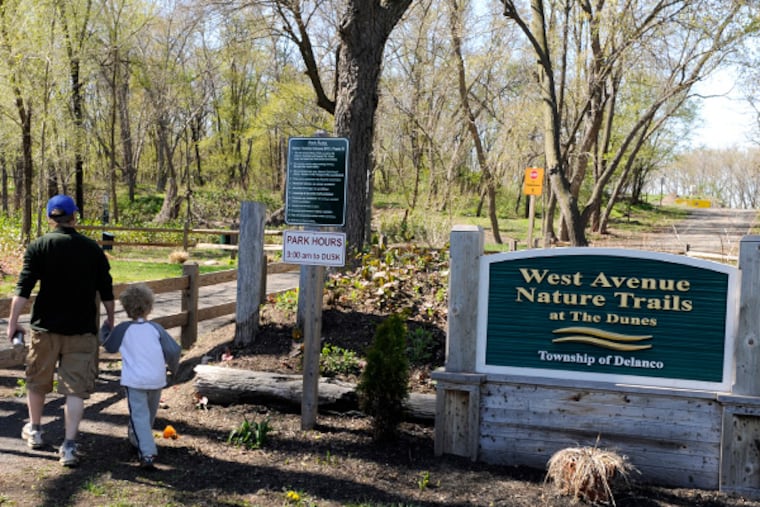Judge: Delanco "Dunes" belong to state, not township
DELANCO A black-and-white aerial photograph of the banks of the Delaware River snapped in 1946 led a judge to conclude much of the "Dunes" area in this tiny community was once underwater and therefore belongs to the state of New Jersey, not the township.

DELANCO A black-and-white aerial photograph of the banks of the Delaware River snapped in 1946 led a judge to conclude much of the "Dunes" area in this tiny community was once underwater and therefore belongs to the state of New Jersey, not the township.
The recent ruling by Superior Court Judge Karen L. Suter paves the way for the state to pursue tentative plans to dump tons of dredge spoils on the land, which is now occupied by hiking trails and a small woods. Under state law, tidal waters and the land beneath them are owned by the state, and these claims can date back to the 1940s.
Doug Heinold, the town's lawyer, would have preferred the judge give more weight to a 1951 photograph. That shot, he said, establishes Delanco's claim to the land because it depicts more marshland, as opposed to wet mud flats, a distinction that apparently became critical in this unusual territorial dispute.
"We're not happy," said Mayor Bill Dillenbeck. "It's one of the few open spaces left and they're taking it away from the people."
This month, the town committee voted to appeal.
The court fight began two years ago, when the town created trails and announced a ribbon-cutting for a new park at the 35-acre site. Nearly 60 years ago, the land was a dumping ground for river sediment. But when the dredging stopped more than 25 years ago, trees grew throughout the hilly area and the views from paths high above the river attracted nature-lovers.
The DEP sued to stop the ribbon-cutting, saying the township was encroaching on its land. The agency, charged with finding places for dredge spoils, was considering land in Delanco, Cinnaminson, Palmyra, and Burlington Island as potential depositories.
"We're concerned about the safety issues out there" in the channel, DEP spokesman Larry Hajna said, referring to the build-up of shoals. He said the Army Corps of Engineers periodically dredged the river to keep it navigable for ships.
Pennsylvania's DEP has the same duty when the Corps of Engineers dredges its side of the river.
Suter decided Delanco could open its park but agreed to hold a trial to settle the ownership issue.
After a six-day trial, Suter said in an 18-page opinion the 1946 photograph had been analyzed by trained staff who used a stereographic microscope and found much of the land was submerged or had been underwater, based on the appearance of mud flats. "It was acknowledged that this area was affected by the tides in 1946. There was a seven-foot tide," she said.
But Heinold said there also was evidence that shows the DEP incorrectly drew the tidelands line too far inland. Of the 35 acres, the judge agreed with the DEP's assessment that roughly 20 acres belongs to the state, he said. "In addition to claiming the streams found on the land, they were claiming large expanses on either side, which they claim is wet mud or tidal mud flats. But our expert believes it's marsh and should not have been claimed," he said.
Dillenbeck said if the ruling stands, DEP officials have proposed "digging out the trees and foliage that's already there and making a big bowl." Then, he said, the Army Corps of Engineers would haul the debris out and create truck traffic in the adjacent quiet neighborhood. As the dredging continues, he said, so would the truck traffic.
The maintenance dredging is separate from a Delaware River deepening project that is lowering the riverbed by five feet, to 45 feet, between Delaware and Philadelphia.
About four years ago, DEP officials informed Delanco a 250,000-cubic-yard mound was planned for the Dunes area, Hajna said. But the agency still has not decided where the maintenance spoils would be dumped. "We have to discuss this internally, but there is no deadline," he said.